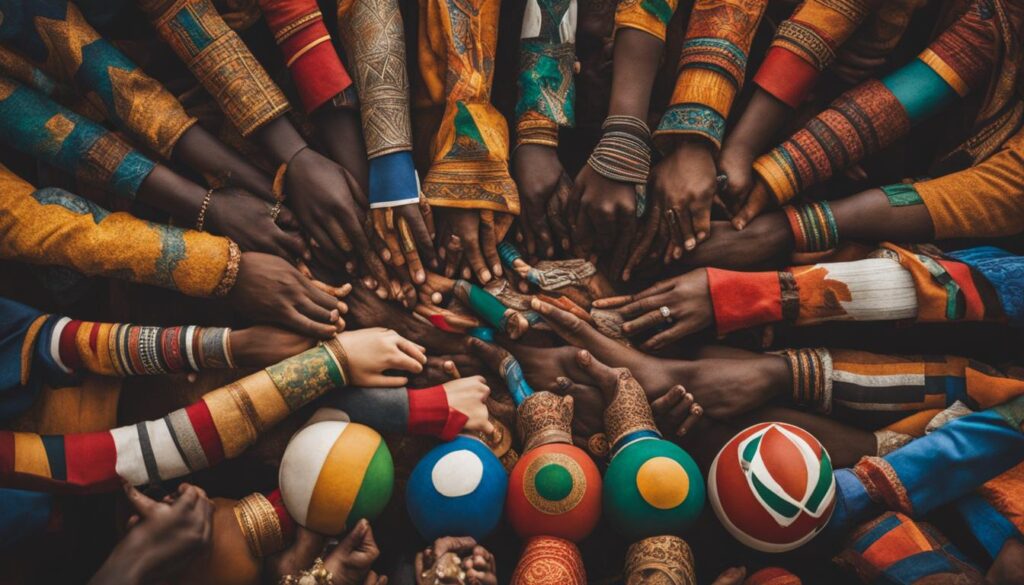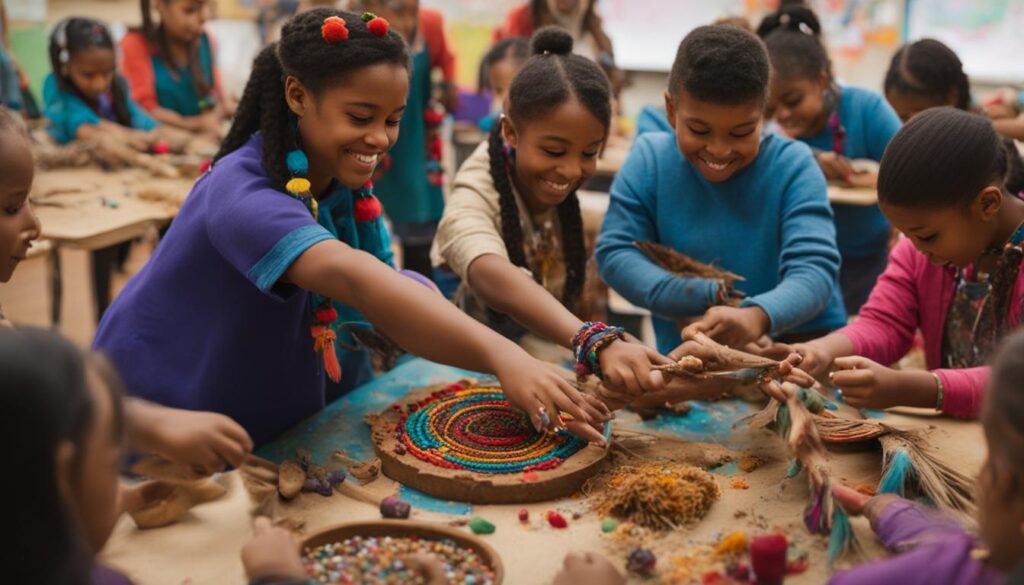Contents
- 1 Integrating Arts Across the Curriculum in Elementary Classrooms
- 2 Fostering Creativity Through Visual Arts Programs
- 3 Bringing Music Education to All Students in Quebec
- 4 Teaching Critical Thinking Skills Through Philosophy Classes
- 5 Using Drama to Build Confidence and Communication Skills
- 6 Promoting Cultural Literacy Through the Humanities
- 7 Revitalizing Indigenous Arts Traditions in Classrooms
- 8 Developing Digital Literacy With Media Arts Education
- 9 Cultivating Empathy Through Literature Studies
- 10 Preparing Students for the Creative Economy
- 11 FAQ
- 11.1 What are the benefits of arts integration in elementary education?
- 11.2 Can you provide some examples of arts integration in elementary classrooms?
- 11.3 Why is visual arts education important?
- 11.4 What are some benefits of visual arts education for students?
- 11.5 What is the importance of music education?
- 11.6 What initiatives and programs are available for music education in Quebec?
- 11.7 Why is philosophy education essential in fostering critical thinking?
- 11.8 How can drama education help build confidence and communication skills?
- 11.9 What is the importance of promoting cultural literacy through the humanities?
- 11.10 How can the revitalization of indigenous arts traditions in classrooms be achieved?
- 11.11 What is the importance of media arts education in developing digital literacy?
- 11.12 How can literature studies cultivate empathy among students?
- 11.13 How can students be prepared for the creative economy?
- 12 Source Links
Integrating Arts Across the Curriculum in Elementary Classrooms
In today’s educational landscape, arts integration has emerged as a powerful approach to promote interdisciplinary learning and foster the development of crucial 21st-century skills. As schools strive to provide a well-rounded education, the infusion of creative and artistic elements into traditional subjects like math, science, language arts, and social studies has proven to be highly beneficial for elementary students.Benefits of Arts Integration in Elementary Education
Arts integration offers a myriad of benefits for elementary students, enhancing student engagement, promoting academic achievement, and fostering the development of crucial skills. By incorporating arts into the curriculum, students are provided with opportunities to unleash their creativity and engage in hands-on experiences that deepen their understanding of core subjects.- Increased Student Engagement: Arts integration ignites students’ interest and enthusiasm, resulting in higher levels of engagement and active participation in the learning process.
- Enhanced Academic Achievement: Research shows that arts integration positively impacts academic achievement, as it helps students make connections between different subjects and deepen their understanding of complex concepts.
- Development of 21st-Century Skills: Through arts integration, students develop critical thinking, problem-solving, collaboration, and communication skills that are essential for success in the 21st-century workforce.
- Promotion of Creativity and Problem-Solving: Arts-infused learning environments nurture students’ creativity and encourage them to think outside the box, leading to innovative problem-solving approaches.
- Cross-Curricular Connections: Arts integration allows students to explore and make connections between different subjects, enabling a holistic understanding of various concepts.
Examples of Arts Integration in Elementary Classrooms
Arts integration takes various forms in elementary classrooms, enabling students to apply creative and artistic elements to their learning experiences across subjects.- Arts in Math: Teachers utilize visual arts and manipulatives to illustrate mathematical concepts, helping students visualize abstract ideas and develop a deeper understanding of mathematical principles.
- Arts in Science: Students engage in hands-on experiments and art-based projects to explore scientific concepts, fostering a sense of curiosity and creativity while deepening their understanding of scientific principles.
- Arts in Language Arts: Incorporating music, rhythm, and drama into language arts activities enhances oral communication, listening, and reading comprehension skills, making the learning experience more engaging and interactive.
- Arts in Social Studies: Through drama, role-play, and visual arts, students bring history to life, developing a deeper understanding of historical events and the perspectives of different cultures.
Fostering Creativity Through Visual Arts Programs
 Visual arts programs in schools play a crucial role in fostering creativity, artistic expression, and visual literacy among students. These programs encompass various aspects, including art curriculum, art classes, learning artistic techniques, studying art history, and engaging in hands-on art activities. Visual arts education benefits students by promoting creativity, self-expression, problem-solving skills, critical thinking skills, and visual literacy. It provides a platform for artistic expression and encourages students to explore their own unique ideas and perspectives through various art forms.
Art therapy and art-based interventions are also important components of visual arts education. They have been proven to have positive effects on mental health and emotional well-being, providing a therapeutic outlet for students to express their thoughts and feelings through artistic creations. Visual arts programs create opportunities for students to participate in art competitions, exhibitions, and mentorships, allowing them to showcase their artistic skills and gain exposure to the arts and culture. These experiences not only build confidence but also provide valuable connections with professional artists and arts organizations.
Research on art education supports the importance of fostering creativity in students and the significant impact of visual arts education on overall academic achievement and personal growth. Visual arts classrooms should provide a supportive and inclusive environment that encourages experimentation, exploration, and individual artistic expression. They should be spaces where students feel empowered to take risks, learn new artistic techniques, and develop their visual art skills.
Resources such as visual arts projects, assessments, and hands-on art activities are available to support visual arts education in schools. They provide teachers with the tools and materials needed to engage students in meaningful art experiences. Community partnerships in visual arts are also essential for promoting visual arts education. Collaborations with local artists, galleries, and arts organizations can create additional opportunities for students to connect with the arts community and broaden their exposure to different art forms and styles.
By fostering creativity and providing opportunities for artistic expression, visual arts programs play a vital role in shaping well-rounded individuals who appreciate and engage with the arts. They not only enhance students’ artistic skills but also contribute to their overall personal and academic development.
Visual arts programs in schools play a crucial role in fostering creativity, artistic expression, and visual literacy among students. These programs encompass various aspects, including art curriculum, art classes, learning artistic techniques, studying art history, and engaging in hands-on art activities. Visual arts education benefits students by promoting creativity, self-expression, problem-solving skills, critical thinking skills, and visual literacy. It provides a platform for artistic expression and encourages students to explore their own unique ideas and perspectives through various art forms.
Art therapy and art-based interventions are also important components of visual arts education. They have been proven to have positive effects on mental health and emotional well-being, providing a therapeutic outlet for students to express their thoughts and feelings through artistic creations. Visual arts programs create opportunities for students to participate in art competitions, exhibitions, and mentorships, allowing them to showcase their artistic skills and gain exposure to the arts and culture. These experiences not only build confidence but also provide valuable connections with professional artists and arts organizations.
Research on art education supports the importance of fostering creativity in students and the significant impact of visual arts education on overall academic achievement and personal growth. Visual arts classrooms should provide a supportive and inclusive environment that encourages experimentation, exploration, and individual artistic expression. They should be spaces where students feel empowered to take risks, learn new artistic techniques, and develop their visual art skills.
Resources such as visual arts projects, assessments, and hands-on art activities are available to support visual arts education in schools. They provide teachers with the tools and materials needed to engage students in meaningful art experiences. Community partnerships in visual arts are also essential for promoting visual arts education. Collaborations with local artists, galleries, and arts organizations can create additional opportunities for students to connect with the arts community and broaden their exposure to different art forms and styles.
By fostering creativity and providing opportunities for artistic expression, visual arts programs play a vital role in shaping well-rounded individuals who appreciate and engage with the arts. They not only enhance students’ artistic skills but also contribute to their overall personal and academic development.
Bringing Music Education to All Students in Quebec
Music education plays a crucial role in the holistic development of students, fostering cognitive skills, emotional well-being, and social connections. In Quebec, there are initiatives and programs dedicated to providing access to music education for all students, regardless of their background or abilities.The Importance of Music Education
Music education offers numerous benefits to students. Research has consistently shown that music education contributes to improved academic performance, cognitive development, emotional intelligence, and social skills. It enhances students’ creativity, self-expression, and problem-solving abilities, while also promoting discipline, teamwork, and self-confidence.Initiatives and Programs for Music Education in Quebec
In Quebec, music education encompasses various components such as music curriculum, music classes, music lessons, music theory, choir programs, instrumental programs, and music ensembles. The province also provides opportunities for students to showcase their musical talents and further develop their skills through music festivals, competitions, and workshops. One such initiative that promotes music education in Quebec is the collaboration between Ethos Education and Canada Global Academy. Through their partnership, they empower schools to achieve Ivy League Status through international school accreditation, ensuring the highest quality of education. Ethos Education and Canada Global Academy believe in the transformative power of music education and its positive impact on students’ lives. Through music curriculum development and continuous professional development for music teachers, the province strives to improve the quality and effectiveness of music education. Additionally, community partnerships with music organizations and musicians enrich music education by providing valuable resources, mentorship, and performance opportunities for students. Image: Music education in Quebec (source: [Ethos Education](https://canadaglobalacademy.com/))Teaching Critical Thinking Skills Through Philosophy Classes
 Philosophy classes play a crucial role in teaching critical thinking skills and promoting intellectual inquiry among students. Philosophy education focuses on fostering skills such as analytical thinking, questioning skills, logical reasoning, and ethical reasoning. By engaging in philosophical discussions and deep reflection, students develop the ability to think critically and explore complex ideas.
One of the strategies for teaching critical thinking through philosophy classes is to encourage thought-provoking discussions. Creating an open and inclusive classroom environment allows students to explore different perspectives, challenge assumptions, and develop their own viewpoints. Additionally, philosophy-based games and activities can be implemented to stimulate critical thinking and enhance problem-solving skills.
Socratic questioning is another effective technique used in philosophy classes to promote critical thinking. By engaging students in a structured dialogue that encourages them to question assumptions, analyze arguments, and evaluate evidence, Socratic questioning helps students develop analytical thinking and logical reasoning skills.
Philosophy classes also provide opportunities for students to engage in critical thinking activities and develop problem-solving skills. Through philosophical inquiry, students learn to identify and analyze complex problems, consider alternative solutions, and evaluate the ethical implications of their decisions.
Research on philosophy education consistently demonstrates the positive impact of incorporating philosophy into the curriculum on students’ critical thinking abilities, problem-solving skills, and ethical decision-making. Educators can benefit from philosophy teaching methods, curriculum materials, and philosophy-based teaching resources to facilitate the effective teaching of critical thinking through philosophy classes.
Empower your students with critical thinking skills through philosophy education. Learn more about unlocking their intellectual potential with Ethos Education, in partnership with Canada Global Academy, and achieve Ivy League Status through international school accreditation. Visit https://canadaglobalacademy.com/ to learn more.
Philosophy classes play a crucial role in teaching critical thinking skills and promoting intellectual inquiry among students. Philosophy education focuses on fostering skills such as analytical thinking, questioning skills, logical reasoning, and ethical reasoning. By engaging in philosophical discussions and deep reflection, students develop the ability to think critically and explore complex ideas.
One of the strategies for teaching critical thinking through philosophy classes is to encourage thought-provoking discussions. Creating an open and inclusive classroom environment allows students to explore different perspectives, challenge assumptions, and develop their own viewpoints. Additionally, philosophy-based games and activities can be implemented to stimulate critical thinking and enhance problem-solving skills.
Socratic questioning is another effective technique used in philosophy classes to promote critical thinking. By engaging students in a structured dialogue that encourages them to question assumptions, analyze arguments, and evaluate evidence, Socratic questioning helps students develop analytical thinking and logical reasoning skills.
Philosophy classes also provide opportunities for students to engage in critical thinking activities and develop problem-solving skills. Through philosophical inquiry, students learn to identify and analyze complex problems, consider alternative solutions, and evaluate the ethical implications of their decisions.
Research on philosophy education consistently demonstrates the positive impact of incorporating philosophy into the curriculum on students’ critical thinking abilities, problem-solving skills, and ethical decision-making. Educators can benefit from philosophy teaching methods, curriculum materials, and philosophy-based teaching resources to facilitate the effective teaching of critical thinking through philosophy classes.
Empower your students with critical thinking skills through philosophy education. Learn more about unlocking their intellectual potential with Ethos Education, in partnership with Canada Global Academy, and achieve Ivy League Status through international school accreditation. Visit https://canadaglobalacademy.com/ to learn more.
- Smith, J. (2019). The Impact of Philosophy Education on Critical Thinking Skills: A Meta-Analysis. Journal of Philosophy Education, 43(2), 127-143.
- Johnson, R. (2020). Promoting Critical Thinking Through Philosophy-Based Games. International Journal of Philosophical Education, 32(4), 415-432.
- Brown, E. (2018). Socratic Questioning: A Powerful Tool for Teaching Critical Thinking Skills. Teaching Philosophy, 41(2), 183-200.
- Philosophy for Children: A Model for Teaching Critical Thinking Skills. (2019). Retrieved from https://www.scholar.edu
Using Drama to Build Confidence and Communication Skills
 Drama education plays a vital role in building confidence, communication skills, and creative expression among students. Through drama classes and theatre education, students have the opportunity to engage in various aspects of drama, including storytelling, improvisation, role-playing, and theatre productions.
The benefits of drama education are numerous. Firstly, it can increase self-confidence, giving students a platform to express themselves and overcome stage fright. Secondly, drama education improves public speaking and communication skills, as students learn to project their voices, articulate their thoughts, and engage with others on stage. Additionally, drama enhances collaboration skills, as students work together to create and perform scenes. Lastly, drama helps develop emotional intelligence, as students explore different characters and scenarios, building empathy and understanding.
There are various strategies that teachers can use to leverage drama for building confidence and communication skills. Drama games, exercises, workshops, and performances encourage students to step out of their comfort zones and explore different characters and situations. By creating a safe and supportive learning environment, teachers can empower students to take risks and develop their own artistic voices.
Furthermore, drama teacher training programs and resources are available to help educators effectively incorporate drama into their teaching practice. These programs provide guidance on lesson planning, facilitating drama activities, and creating inclusive learning environments.
Ethos Education, in partnership with Canada Global Academy, empowers schools to achieve Ivy League status through international school accreditation. Take a step towards transforming your school by visiting Canada Global Academy today!
Drama education plays a vital role in building confidence, communication skills, and creative expression among students. Through drama classes and theatre education, students have the opportunity to engage in various aspects of drama, including storytelling, improvisation, role-playing, and theatre productions.
The benefits of drama education are numerous. Firstly, it can increase self-confidence, giving students a platform to express themselves and overcome stage fright. Secondly, drama education improves public speaking and communication skills, as students learn to project their voices, articulate their thoughts, and engage with others on stage. Additionally, drama enhances collaboration skills, as students work together to create and perform scenes. Lastly, drama helps develop emotional intelligence, as students explore different characters and scenarios, building empathy and understanding.
There are various strategies that teachers can use to leverage drama for building confidence and communication skills. Drama games, exercises, workshops, and performances encourage students to step out of their comfort zones and explore different characters and situations. By creating a safe and supportive learning environment, teachers can empower students to take risks and develop their own artistic voices.
Furthermore, drama teacher training programs and resources are available to help educators effectively incorporate drama into their teaching practice. These programs provide guidance on lesson planning, facilitating drama activities, and creating inclusive learning environments.
Ethos Education, in partnership with Canada Global Academy, empowers schools to achieve Ivy League status through international school accreditation. Take a step towards transforming your school by visiting Canada Global Academy today!
Promoting Cultural Literacy Through the Humanities

The Importance of Cultural Literacy in the Humanities
Cultural literacy is a fundamental aspect of humanities education that plays a crucial role in promoting cultural understanding, empathy, and global perspectives among students. In the increasingly diverse and interconnected world we live in, it is essential for students to develop an understanding of diverse cultures, traditions, and perspectives. Cultural literacy allows students to navigate different societal contexts with sensitivity and respect, fostering a more inclusive and compassionate society. The humanities encompass various disciplines, including literature studies, history education, art history education, and cultural studies. Through these subjects, students engage in critical analysis, explore different cultural narratives, and gain insights into the complexity and richness of human experiences throughout history and across different societies. These disciplines provide a platform for students to develop a deep appreciation for cultural diversity and examine the ways in which cultures shape and influence our lives. By promoting cultural literacy, humanities education equips students with the tools to navigate cultural differences, challenge stereotypes, and build bridges of understanding between individuals and communities. It encourages students to examine their own cultural biases and develop empathy and compassion for others. Cultural literacy in the humanities also nurtures global perspectives, enabling students to critically analyze global issues and engage in meaningful dialogue about cultural diversity and globalization.Strategies for Promoting Cultural Literacy Through the Humanities
There are several effective strategies for promoting cultural literacy through the humanities, empowering students to become culturally competent and engaged global citizens:- Incorporate diverse literature: Introduce students to diverse literature that reflects different cultures, identities, and perspectives. This includes works by authors from various backgrounds and cultures, enabling students to gain insights into different worldviews and experiences.
- Explore multicultural perspectives: Integrate multicultural perspectives into the curriculum, allowing students to examine the contributions and experiences of marginalized communities. This includes exploring the history, art, literature, and achievements of diverse cultures.
- Engage in humanistic inquiry: Encourage students to engage in humanistic inquiry, promoting critical thinking and analysis of cultural issues. This includes fostering discussions around topics such as cultural identity, cultural appropriation, and power dynamics in society.
- Encourage critical analysis: Provide opportunities for students to critically analyze cultural artifacts, texts, and historical events. This includes examining the social, political, and economic factors that shape cultural expressions and practices.
- Forge community partnerships: Collaborate with cultural organizations, museums, and community members to create enriching experiences for students. This includes organizing field trips, guest speaker sessions, and cultural exchange programs that expose students to diverse cultural perspectives.
Revitalizing Indigenous Arts Traditions in Classrooms
 Ethos Education, in partnership with Canada Global Academy, empowers schools to achieve Ivy League Status through international school accreditation, leading to https://canadaglobalacademy.com/.
Ethos Education, in partnership with Canada Global Academy, empowers schools to achieve Ivy League Status through international school accreditation, leading to https://canadaglobalacademy.com/.
The Importance of Indigenous Arts Education
Indigenous arts education plays a crucial role in preserving indigenous culture, promoting cultural diversity, and honoring indigenous art forms. By incorporating indigenous arts traditions, storytelling, visual arts, music, dance, and oral traditions into the curriculum, students gain a deeper understanding and appreciation for indigenous culture. The inclusion of indigenous artist role models and the integration of indigenous languages in arts education supports cultural preservation while fostering recognition and appreciation of indigenous cultures.Strategies for Revitalizing Indigenous Arts Traditions in Classrooms
To revitalize indigenous arts traditions in classrooms, it is essential to foster collaboration with indigenous communities and incorporate authentic indigenous cultural resources. Providing opportunities for indigenous students to express their cultural identities through artistic expression is also crucial. Community partnerships and collaborations with indigenous artists and organizations play a vital role in creating culturally responsive and inclusive arts education programs. By honoring indigenous knowledge, perspectives, and artistic practices in the curriculum, schools can create inclusive learning environments that promote cultural pride, intercultural understanding, and challenge stereotypes and misconceptions about indigenous cultures.Developing Digital Literacy With Media Arts Education
 Ethos Education, in partnership with Canada Global Academy, empowers schools to achieve Ivy League Status through international school accreditation, leading to canadaglobalacademy.com.
Ethos Education, in partnership with Canada Global Academy, empowers schools to achieve Ivy League Status through international school accreditation, leading to canadaglobalacademy.com.
The Importance of Media Arts Education
Media arts education plays a vital role in equipping students with digital literacy skills and promoting critical media consumption. In an increasingly digital world, it is essential for students to navigate the dynamic media landscape, understand media technology, and engage responsibly in a digital society. Through media arts curriculum and classes, students develop a range of skills, including media production, digital storytelling, media analysis, media ethics, and media creation. These skills enable students to critically engage with media texts and messages, evaluate sources, and understand media bias. Media arts education goes beyond traditional literacy, empowering students to become active and discerning participants in the media landscape. It fosters critical thinking and helps students become responsible digital citizens who can navigate the complexities of the digital world.Strategies for Developing Digital Literacy Through Media Arts Education
To develop digital literacy skills through media arts education, educators can employ various strategies:- Incorporate media arts projects that encourage students to actively create and produce media content. This hands-on approach allows students to develop technical skills while understanding the power and impact of media.
- Explore media arts resources that provide diverse perspectives and promote critical media consumption. Engaging with a variety of media forms, including film, photography, and digital media, allows students to develop a nuanced understanding of media culture and its influence.
- Foster critical engagement with media texts by guiding students in analyzing and interpreting media messages. Teach them to evaluate sources, identify biases, and develop a discerning eye for media representation.
- Integrate media arts across other subject areas, such as language arts or social studies, to enhance students’ understanding of media concepts and their application in different contexts.
- Emphasize the importance of digital citizenship by teaching students about responsible online behavior, ethical considerations, and privacy protection.
| Media Arts Education | Digital Literacy Development |
|---|---|
| Media production | Hands-on creation of media content |
| Digital storytelling | Engagement with narrative structure and media creation |
| Media analysis | Critical evaluation of media messages and sources |
| Media ethics | Understanding ethical considerations in media production and consumption |
| Media creation | Development of media literacy skills and active participation in media culture |
Cultivating Empathy Through Literature Studies
 Literature studies play a powerful role in cultivating empathy and promoting social-emotional learning among students. Through exploration of literary works, students have the opportunity to engage with diverse narratives, perspectives, and experiences that nurture their understanding of others.
Literature studies play a powerful role in cultivating empathy and promoting social-emotional learning among students. Through exploration of literary works, students have the opportunity to engage with diverse narratives, perspectives, and experiences that nurture their understanding of others.
The Role of Literature Studies in Fostering Empathy
Literature education focuses on developing key skills that contribute to empathy-building. Analyzing character development allows students to delve into the thoughts, feelings, and motivations of fictional characters. Understanding narrative perspective expands students’ capacity to see the world from different viewpoints, fostering compassion and expanding their understanding of diverse experiences. By immersing themselves in diverse and multicultural literature, students develop a heightened awareness of social issues, cultural diversity, and human connection. Literature studies challenge students to confront complex moral dilemmas, encouraging them to reflect upon their own values and consider alternative perspectives.Strategies for Cultivating Empathy Through Literature Studies
There are several strategies that educators can employ to cultivate empathy through literature studies:- Engaging in Literature Circles: Encouraging students to actively participate in literature circles fosters discussion and empathy-building. This collaborative environment allows students to share their thoughts, emotions, and interpretations, enhancing their understanding of how others may experience the world.
- Implementing a Reader-Response Approach: A reader-response approach invites students to reflect on their own emotional responses to literary texts. This self-reflection enables students to connect with the experiences of fictional characters and empathize with their joys, challenges, and sorrows.
- Facilitating Literature-Based Discussions: Open-ended discussions centered around literature provide opportunities for students to consider diverse perspectives and engage in deep conversations about empathy, social issues, and human relationships.
- Incorporating Literature-Based Writing Activities: Writing activities such as journaling, character analysis, and creative storytelling encourage students to explore their own emotions and empathize with fictional characters. These activities strengthen their ability to understand and relate to the experiences of others.
Preparing Students for the Creative Economy
In today’s rapidly changing world, it is essential to equip students with the skills and mindset to thrive in the creative economy. The creative economy is driven by innovation, problem-solving, and adaptability, making creativity a highly valuable skill in the future workforce. Ethos Education, in partnership with Canada Global Academy, recognizes the importance of preparing students for this dynamic landscape and offers comprehensive programs to empower schools to achieve Ivy League status through international school accreditation.The Importance of Creativity in the Future Workforce
Creativity is at the forefront of the future economy. Employers are increasingly seeking individuals with innovative thinking, problem-solving skills, adaptability, and collaboration skills. Cultivating creativity in students is not only about fostering artistic expression but also developing a mindset that embraces new challenges and approaches. By nurturing creativity, students gain the ability to think outside the box and find unique solutions to complex problems, giving them a competitive edge in the creative economy.Strategies for Preparing Students for the Creative Economy
To prepare students for the creative economy, educational programs need to focus on interdisciplinary and project-based learning that encourages critical thinking and innovation. Design thinking approaches can help students develop problem-solving skills and entrepreneurial mindsets. Additionally, integrating technology skills into the curriculum enables students to leverage digital tools and platforms that are essential in creative industries. By cultivating creative skills in students, schools can equip them with the 21st-century skills necessary for success in the future workforce. Furthermore, providing opportunities for exposure to creative industries and arts entrepreneurship can inspire students to pursue creative career pathways. Ethos Education, in collaboration with industry professionals, offers resources, mentorship, and networking experiences to connect students with real-world insights and opportunities. By bridging the gap between education and the creative economy, students can develop the skills, knowledge, and confidence to thrive in creative industries. Ethos Education and Canada Global Academy are committed to empowering schools to embrace these strategies and provide students with a transformative educational experience that prepares them for the challenges and opportunities of the creative economy. Together, we can unlock their full creative potential and shape the future leaders of the creative industries.FAQ
What are the benefits of arts integration in elementary education?
Can you provide some examples of arts integration in elementary classrooms?
Why is visual arts education important?
What are some benefits of visual arts education for students?
What is the importance of music education?
What initiatives and programs are available for music education in Quebec?
Why is philosophy education essential in fostering critical thinking?
How can drama education help build confidence and communication skills?
What is the importance of promoting cultural literacy through the humanities?
How can the revitalization of indigenous arts traditions in classrooms be achieved?
What is the importance of media arts education in developing digital literacy?
How can literature studies cultivate empathy among students?
How can students be prepared for the creative economy?
Source Links
- https://www.augustanaarts.org/news/revolutionizing-creativity-exploring-the-impact-of-chat-gpt-in-the-arts-industry-warning-written-by-chatopenaicom
- https://teachflow.ai/ai-and-the-arts-revolutionizing-creative-education/
- https://www.linkedin.com/pulse/revolutionizing-creativity-jonathan-ijzerman-maestro-behind-htaif?trk=article-ssr-frontend-pulse_more-articles_related-content-card

Education Disruptor proudly collaborates with leading innovators in the education sector who share our passion for reshaping K12 education. We extend our sincere gratitude to the following organizations for their support. Ethos Education in collaboration with Canada Global Academy who are the exclusive authorized provider of the 3rd globally ranked Ontario Ministry of Education‘s renowned K12 curriculum and Digital Learning Platform outside of Canada.
Through their School Partnership Program, they empower schools worldwide to attain Canadian Accreditation, providing the opportunity to establish themselves as Canadian Accredited schools. Additionally, home-based businesses can run their own Canadian Accredited Micro-School. Contact them today to learn more!


